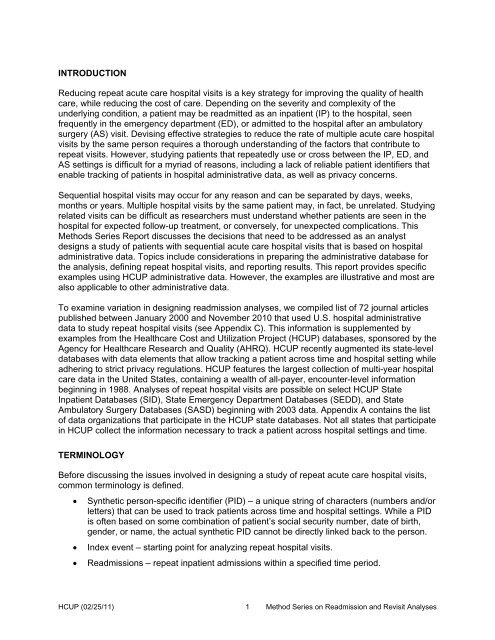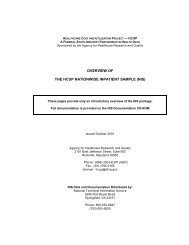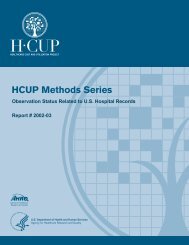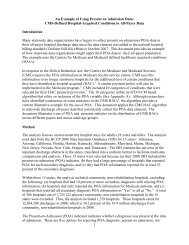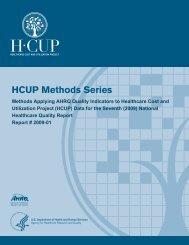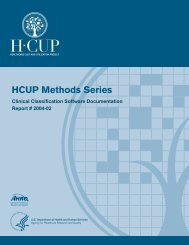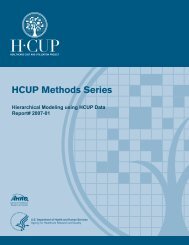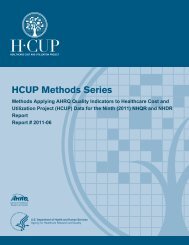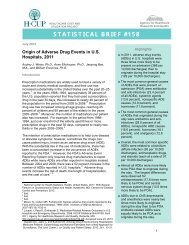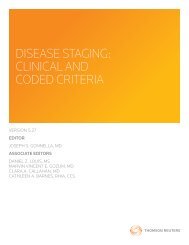Methodological Issues when Studying Readmissions and ... - HCUP
Methodological Issues when Studying Readmissions and ... - HCUP
Methodological Issues when Studying Readmissions and ... - HCUP
Create successful ePaper yourself
Turn your PDF publications into a flip-book with our unique Google optimized e-Paper software.
INTRODUCTIONReducing repeat acute care hospital visits is a key strategy for improving the quality of healthcare, while reducing the cost of care. Depending on the severity <strong>and</strong> complexity of theunderlying condition, a patient may be readmitted as an inpatient (IP) to the hospital, seenfrequently in the emergency department (ED), or admitted to the hospital after an ambulatorysurgery (AS) visit. Devising effective strategies to reduce the rate of multiple acute care hospitalvisits by the same person requires a thorough underst<strong>and</strong>ing of the factors that contribute torepeat visits. However, studying patients that repeatedly use or cross between the IP, ED, <strong>and</strong>AS settings is difficult for a myriad of reasons, including a lack of reliable patient identifiers thatenable tracking of patients in hospital administrative data, as well as privacy concerns.Sequential hospital visits may occur for any reason <strong>and</strong> can be separated by days, weeks,months or years. Multiple hospital visits by the same patient may, in fact, be unrelated. <strong>Studying</strong>related visits can be difficult as researchers must underst<strong>and</strong> whether patients are seen in thehospital for expected follow-up treatment, or conversely, for unexpected complications. ThisMethods Series Report discusses the decisions that need to be addressed as an analystdesigns a study of patients with sequential acute care hospital visits that is based on hospitaladministrative data. Topics include considerations in preparing the administrative database forthe analysis, defining repeat hospital visits, <strong>and</strong> reporting results. This report provides specificexamples using <strong>HCUP</strong> administrative data. However, the examples are illustrative <strong>and</strong> most arealso applicable to other administrative data.To examine variation in designing readmission analyses, we compiled list of 72 journal articlespublished between January 2000 <strong>and</strong> November 2010 that used U.S. hospital administrativedata to study repeat hospital visits (see Appendix C). This information is supplemented byexamples from the Healthcare Cost <strong>and</strong> Utilization Project (<strong>HCUP</strong>) databases, sponsored by theAgency for Healthcare Research <strong>and</strong> Quality (AHRQ). <strong>HCUP</strong> recently augmented its state-leveldatabases with data elements that allow tracking a patient across time <strong>and</strong> hospital setting whileadhering to strict privacy regulations. <strong>HCUP</strong> features the largest collection of multi-year hospitalcare data in the United States, containing a wealth of all-payer, encounter-level informationbeginning in 1988. Analyses of repeat hospital visits are possible on select <strong>HCUP</strong> StateInpatient Databases (SID), State Emergency Department Databases (SEDD), <strong>and</strong> StateAmbulatory Surgery Databases (SASD) beginning with 2003 data. Appendix A contains the listof data organizations that participate in the <strong>HCUP</strong> state databases. Not all states that participatein <strong>HCUP</strong> collect the information necessary to track a patient across hospital settings <strong>and</strong> time.TERMINOLOGYBefore discussing the issues involved in designing a study of repeat acute care hospital visits,common terminology is defined.• Synthetic person-specific identifier (PID) – a unique string of characters (numbers <strong>and</strong>/orletters) that can be used to track patients across time <strong>and</strong> hospital settings. While a PIDis often based on some combination of patient’s social security number, date of birth,gender, or name, the actual synthetic PID cannot be directly linked back to the person.• Index event – starting point for analyzing repeat hospital visits.• <strong>Readmissions</strong> – repeat inpatient admissions within a specified time period.<strong>HCUP</strong> (02/25/11)1Method Series on Readmission <strong>and</strong> Revisit Analyses


